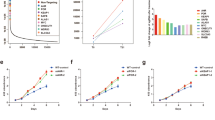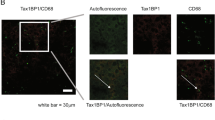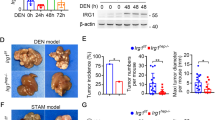Abstract
Hepatocellular carcinoma (HCC) is a significant worldwide health concern that is associated with discrete etiological events, encompassing viral infection, metabolic stress and genotoxic compounds. In particular, exposure to the genotoxic hepatocarcinogen aflatoxin B1 (AFB1) is a significant factor in the genesis of human liver cancer. Presumably, genetic events associated with HCC could influence the effect of environmental insults, yielding a predilection for tumor development. The retinoblastoma (RB) tumor suppressor pathway is functionally inactivated in HCC through discrete mechanisms; however, the role of RB in suppressing tumorigenesis in this disease is poorly understood. Therefore, we analysed how RB status affects the response to AFB1 in reference to acute exposures and tumor development reflective of chronic exposure. Liver-specific Rb deletion resulted in an aberrant proliferative response to AFB1. This cell-cycle induction was associated with increased levels of secondary genetic damage and failure in appropriate cell-cycle coupling. This effect of RB loss was unique to AFB1 and involved the induction of a non-canonical proliferative pathway, and was not merely reflective of the overall cell-cycle deregulation or aberrant regenerative responses. The acute responses to AFB1 exposure presaged aberrations in hepatocyte nuclear morphology and ploidy with RB loss. Correspondingly, RB-deficient livers showed significantly enhanced susceptibility to liver tumorigenesis initiated by AFB1. Combined, these studies show that RB has a critical role in mediating checkpoint responses in liver tissue to maintain genome integrity and in suppressing tumorigenesis.
This is a preview of subscription content, access via your institution
Access options
Subscribe to this journal
Receive 50 print issues and online access
$259.00 per year
only $5.18 per issue
Buy this article
- Purchase on Springer Link
- Instant access to full article PDF
Prices may be subject to local taxes which are calculated during checkout






Similar content being viewed by others
References
Azechi H, Nishida N, Fukuda Y, Nishimura T, Minata M, Katsuma H et al. (2001). Disruption of the p16/cyclin D1/retinoblastoma protein pathway in the majority of human hepatocellular carcinomas. Oncology 60: 346–354.
Bioulac-Sage P, Laurent-Puig P, Balabaud C, Zucman-Rossi J . (2003). Genetic alterations in hepatocellular adenomas. Hepatology 37: 480, author reply 480-1.
Burkhart DL, Sage J . (2008). Cellular mechanisms of tumour suppression by the retinoblastoma gene. Nat Rev Cancer 8: 671–682.
Cobrinik D . (2005). Pocket proteins and cell cycle control. Oncogene 24: 2796–2809.
DeGregori J, Johnson DG . (2006). Distinct and overlapping roles for E2F family members in transcription, proliferation and apoptosis. Curr Mol Med 6: 739–748.
Donehower LA . (1997). Genetic instability in animal tumorigenesis models. Cancer Surv 29: 329–352.
Edamoto Y, Hara A, Biernat W, Terracciano L, Cathomas G, Riehle HM et al. (2003). Alterations of RB1, p53 and Wnt pathways in hepatocellular carcinomas associated with hepatitis C, hepatitis B and alcoholic liver cirrhosis. Int J Cancer 106: 334–341.
Farazi PA, DePinho RA . (2006). Hepatocellular carcinoma pathogenesis: from genes to environment. Nat Rev Cancer 6: 674–687.
Fujimoto Y, Hampton LL, Wirth PJ, Wang NJ, Xie JP, Thorgeirsson SS . (1994). Alterations of tumor suppressor genes and allelic losses in human hepatocellular carcinomas in China. Cancer Res 54: 281–285.
Jemal A, Siegel R, Ward E, Murray T, Xu J, Thun MJ . (2007). Cancer statistics, 2007. CA Cancer J Clin 57: 43–66.
Knudsen KE, Booth D, Naderi S, Sever-Chroneos Z, Fribourg AF, Hunton IC et al. (2000). RB-dependent S-phase response to DNA damage. Mol Cell Biol 20: 7751–7763.
Knudsen ES, Knudsen KE . (2006). Retinoblastoma tumor suppressor: where cancer meets the cell cycle. Exp Biol Med (Maywood) 231: 1271–1281.
Knudsen ES, Knudsen KE . (2008). Tailoring to RB: tumour suppressor status and therapeutic response. Nat Rev Cancer 8: 714–724.
Knudsen ES, Sexton CR, Mayhew CN . (2006). Role of the retinoblastoma tumor suppressor in the maintenance of genome integrity. Curr Mol Med 6: 749–757.
Laurent-Puig P, Zucman-Rossi J . (2006). Genetics of hepatocellular tumors. Oncogene 25: 3778–3786.
Lazareva MN . (1981). Alpha-fetoprotein production by the synchronized regenerating murine liver. Its independence on the phases of the mitotic cycle. Oncodev Biol Med 2: 89–99.
Markey MP, Bergseid J, Bosco EE, Stengel K, Xu H, Mayhew CN et al. (2007). Loss of the retinoblastoma tumor suppressor: differential action on transcriptional programs related to cell cycle control and immune function. Oncogene 26: 6307–6318.
Mayhew CN, Bosco EE, Fox SR, Okaya T, Tarapore P, Schwemberger SJ et al. (2005). Liver-specific pRB loss results in ectopic cell cycle entry and aberrant ploidy. Cancer Res 65: 4568–4577.
Mayhew CN, Carter SL, Fox SR, Sexton CR, Reed CA, Srinivasan SV . et al. (2007). RB loss abrogates cell cycle control and genome integrity to promote liver tumorigenesis. Gastroenterology 133: 976–984.
McGivern DR, Lemon SM . (2008). Tumor suppressors, chromosomal instability, and hepatitis C virus-associated liver cancer. Annu Rev Pathol 4: 399–415.
Munakata T, Nakamura M, Liang Y, Li K, Lemon SM . (2005). Down-regulation of the retinoblastoma tumor suppressor by the hepatitis C virus NS5B RNA-dependent RNA polymerase. Proc Natl Acad Sci USA 102: 18159–18164.
Munakata T, Liang Y, Kim S, McGivern DR, Huibregtse J, Nomoto A et al. (2007). Hepatitis C virus induces E6AP-dependent degradation of the retinoblastoma protein. PLoS Pathog 3: 1335–1347.
Skawran B, Steinemann D, Becker T, Buurman R, Flik J, Wiese B et al. (2008). Loss of 13q is associated with genes involved in cell cycle and proliferation in dedifferentiated hepatocellular carcinoma. Mod Pathol 21: 1479–1489.
Stevens C, La Thangue NB . (2003). A new role for E2F-1 in checkpoint control. Cell Cycle 5: 435–437.
Thorgeirsson SS, Grisham JW . (2002). Molecular pathogenesis of human hepatocellular carcinoma. Nat Genet 31: 339–346.
Wikenheiser-Brokamp KA . (2006). Retinoblastoma family proteins: insights gained through genetic manipulation of mice. Cell Mol Life Sci 63: 767–780.
Yang X, Tang J, Rogler CE, Stanley P . (2003). Reduced hepatocyte proliferation is the basis of retarded liver tumor progression and liver regeneration in the lacking N-acetylglucosaminyltransferase III. Cancer Res 63: 7753–7759.
Yu MC, Yuan JM . (2004). Environmental factors and risk for hepatocellular carcinoma. Gastroenterology 127: S72–S78.
Zhang YJ, Jiang W, Chen CJ, Lee CS, Kahn SM, Santella RM et al. (1993). Amplification and overexpression of cyclin D1 in human hepatocellular carcinoma. Biochem Biophys Res Commun 196: 1010–1016.
Zhang X, Xu HJ, Murakami Y, Sachse R, Yashima K, Hirohashi S et al. (1994). Deletions of chromosome 13q, mutations in retinoblastoma 1, and retinoblastoma protein state in human hepatocellular carcinoma. Cancer Res 54: 4177–4182.
Author information
Authors and Affiliations
Corresponding author
Rights and permissions
About this article
Cite this article
Reed, C., Mayhew, C., McClendon, A. et al. RB has a critical role in mediating the in vivo checkpoint response, mitigating secondary DNA damage and suppressing liver tumorigenesis initiated by aflatoxin B1. Oncogene 28, 4434–4443 (2009). https://doi.org/10.1038/onc.2009.303
Received:
Revised:
Accepted:
Published:
Issue Date:
DOI: https://doi.org/10.1038/onc.2009.303
Keywords
This article is cited by
-
Hepatocellular carcinoma evades RB1-induced senescence by activating the FOXM1–FOXO1 axis
Oncogene (2022)
-
Retinoic acid receptor-related receptor alpha (RORalpha) is a prognostic marker for hepatocellular carcinoma
Tumor Biology (2014)
-
Rb inactivation accelerates neoplastic growth and substitutes for recurrent amplification of cIAP1, cIAP2 and Yap1 in sporadic mammary carcinoma associated with p53 deficiency
Oncogene (2010)



